AUDI A5 COUPE 2016 Owners Manual
Manufacturer: AUDI, Model Year: 2016, Model line: A5 COUPE, Model: AUDI A5 COUPE 2016Pages: 264, PDF Size: 66.92 MB
Page 171 of 264
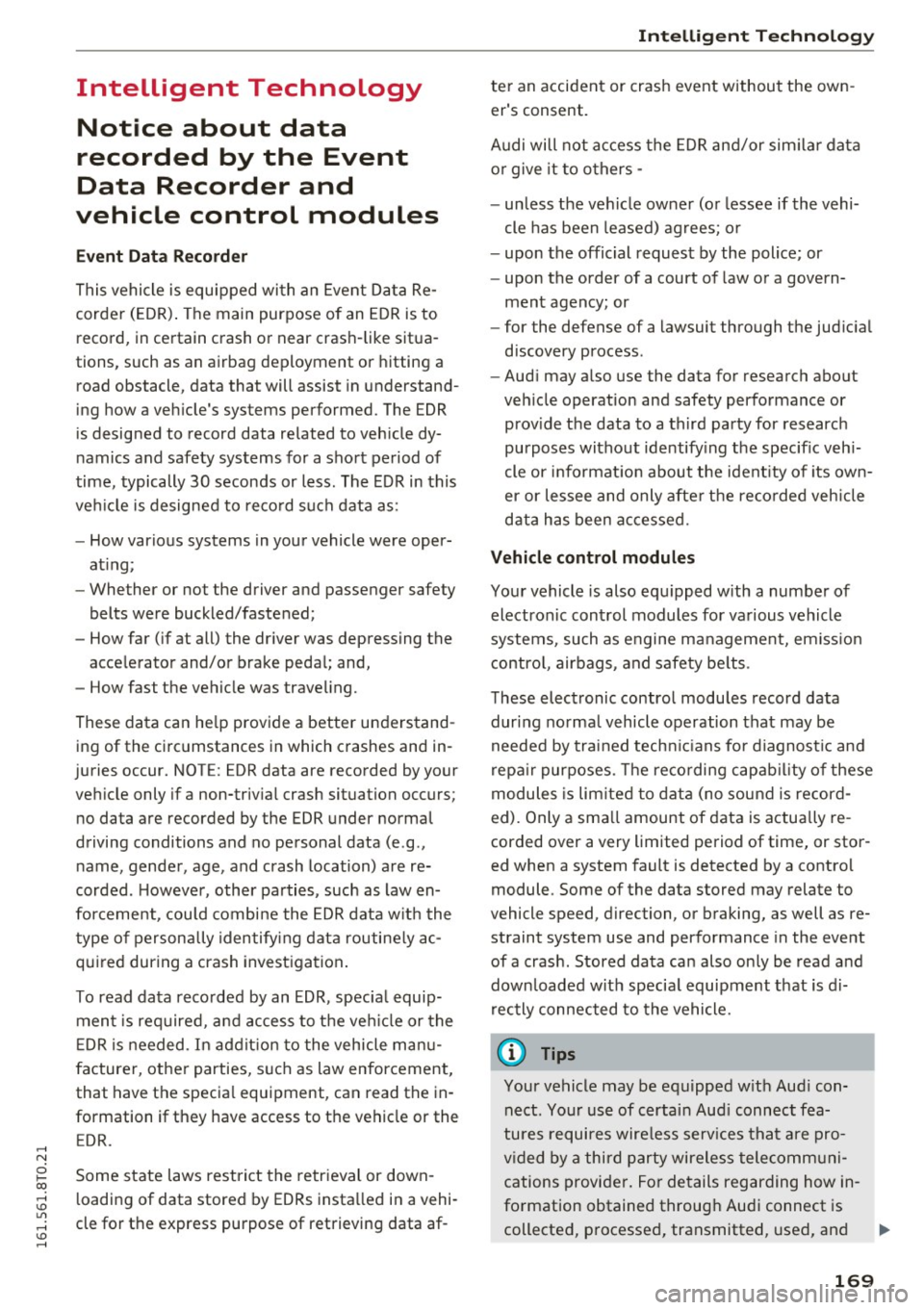
.... N
0 I-co ....
recorded by the Event
Data Recorder and
vehicle control modules
E ve nt Dat a Record er
This vehicle is equipped wi th an Event Data Re
corder (EDR) . The main purpose of an EDR is to
record, in certain crash or near crash-like situa
tions, such as an a irbag deployment or hitting a
road obstacle, data that will assist in understand
ing how a vehicle's systems performed. The EDR
is designed to record data related to vehicle dy
namics and safety systems for a short period of
time, typically 30 seconds or less. The EDR in this
ve hicle is designed to reco rd such data as:
- How various systems in your vehicle were oper
at ing;
- Whether or not the driver and passenger safety
belts were buckled/fastened;
- How far (if at all) the dr iver was depressing the
accelerator and/or brake pedal; and,
- How fast the vehicle was traveling.
These data can he lp provide a better understand
ing of the c ircumstances in which crashes and in
juries occur. NOTE: EDR data are recorded by your
veh icle only if a non-trivia l crash situation occurs;
no data are recorded by the EDR under normal
driving conditions and no personal data (e .g.,
name, gender, age, and crash location) are re
corded. However, other parties, such as law en
forcement, cou ld combine the EDR data w ith the
type of personally identifying data routine ly ac
quired during a crash investigation.
To read data recorded by an EDR, specia l equip
ment is req uired, a nd access to the ve hicle or the
E DR is needed. In add it ion to the vehicle manu
facturer, other parties, such as law enforcement,
that have the specia l equipment, can read the in
formation if they have access to the vehicle or the
EDR .
Some state laws restrict the retr ieval or down
l oading of data stored by ED Rs insta lled in a vehi
cle for the express purpose of retrieving data af-
Intellig ent Technology
ter an accident or crash event without the own
er's consent.
Audi will not ac cess the EDR and/or sim ilar data
o r give it to others -
- unless the vehicle owne r (or lessee if the vehi
cle has been leased) agrees; o r
- upon the official request by the police; or
- upon the order of a court of law or a govern-
ment agency; or
- for the defense of a lawsuit through the judic ial
discovery process.
- Aud i may a lso use the data for research about
veh icle operation and safety performance or
prov ide the data to a third party for research
purposes without identify ing the specific veh i
cle or info rmat io n about the ident ity of its own
er or lessee and only afte r the reco rded veh icle
data has been accessed.
Vehicle control modules
Your vehicle is also equ ipped w ith a number of
electronic control modules for va rious vehicle
systems, such as engine management, emiss io n
contro l, airbags, and s afety be lts.
These electronic control modules record data dur ing norma l vehicle operation that may be
needed by trained tech nicians for diagnost ic and
r epa ir purposes. The re cording capab il ity of these
modules is lim ited to data (no sound is record
ed). Only a sma ll amount of data is actua lly re
corded over a very limited period of time, or stor
ed when a system fault is detected by a control
module . Some of the data stored may relate to
vehicle speed, direction, or braking, as well as re
straint system use and performance in the event
of a crash. Stored data can also on ly be read a nd
down loaded w ith specia l equipment that is d i
rectly connected to the vehicle.
(D Tips
Your vehicle may be equipped w ith Aud i con
nect. Your use of certain Aud i connect fea
tures requi res wire less serv ices that are pro
v ided by a third party wireless telecomm uni
cations provi der. For de tails regarding how in
formation obtained through Aud i connect is
collected, processed, transmitted, used, and ..,.
169
Page 172 of 264
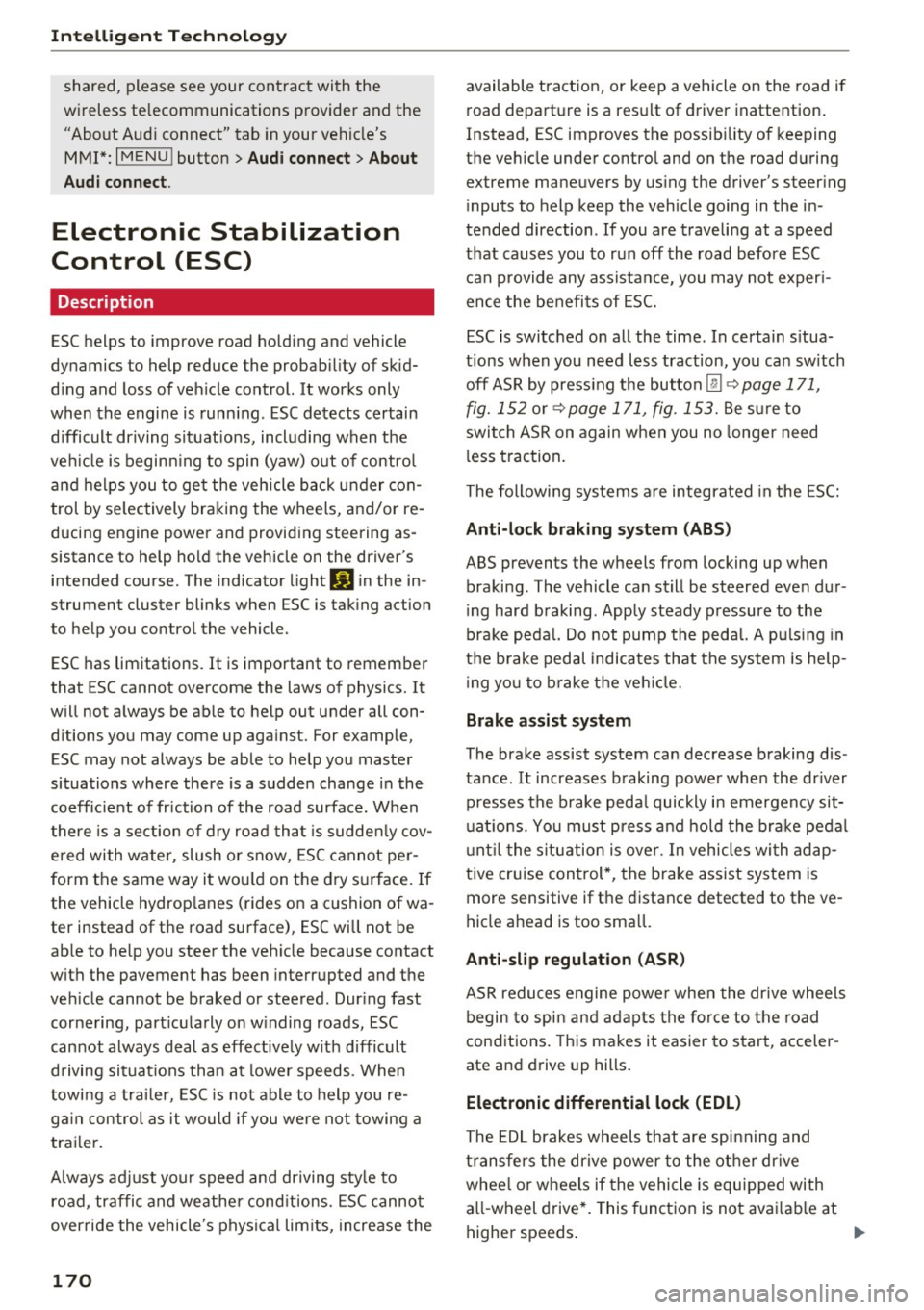
Intelligent Technology
shared, please see your contract with the
wireless te lecommunications provider and the
"About Aud i connect" tab in your vehicle's
MMI*:
I MENU ! button > Audi connect > About
Audi con nect .
Electronic Stabilization
Control (ESC)
Description
E SC helps to imp rove ro a d hold ing and vehicle
dynamics to help reduce the probab ility of skid
d ing and loss of veh icle control. It works only
when the engine is runn ing . ESC detects certain
d iffic ult dr iving situat io ns, including when the
ve hicl e is begin ning to spin (yaw) o ut of contro l
a nd h elps you to ge t the veh icle b ack u nder con
trol by se lectively braking the wheels, and/or re
ducing engine powe r and providing steering as
sistance to help hold the vehicle on the driver's intended course. The indicator light
GI in the in
strument cluster blinks when ESC is tak ing action
t o he lp you contro l the vehicle.
ESC has lim itations. It is important to remembe r
that ESC cannot overcome the laws of physics. It
will not a lways be able to help out under all con
d itions you may come up aga inst . For example,
ESC may not always be able to help you master
situations where there is a sudde n change in the
coeff ic ie nt of fr iction of the road surface. W hen
there is a se ction of dry road tha t is sudde nly cov
e red with w ater, slush o r sn ow , ESC c annot pe r
form the same way i t wou ld on the dry s urface. If
the vehicle hydrop lanes (rides on a cushion of wa
ter instead of t he road su rface), ESC wi ll not be
ab le to he lp you stee r the veh icle because contact
with the pavement has been inter rupted and the
ve hicle cannot be b raked or steered . Dur ing fast
cornering, part icu larly on w inding roads, ESC
can not always deal as effect ive ly w it h difficult
d riving situat ions than a t lowe r speeds . When
towi ng a trail er, ES C i s not able to help you re
g ai n con trol as it would if you we re not towing a
tra ile r.
A lways ad just yo ur speed and driving sty le to
road , tr affic and weathe r cond itions. ESC canno t
override the vehicle's phys ical lim its, incre ase the
170
available tract ion, or keep a vehicle on the road i f
r oad depa rt u re is a res ult of d river inattention .
Instead, ESC improves the poss ib ili ty of keeping
the ve hicle unde r contro l and on the road d uring
extreme maneuvers by using the driver's steer ing
i nputs to help keep the vehicle going in the in
tended direction . If you are traveli ng at a speed
t h at causes you to r un off the road before ESC
can p rovide any assista nce, you may not exper i
ence the benefi ts of ESC.
ESC is switched on all the time. In certa in s itua
tions when you need less tract ion, yo u can sw itch
off AS R by press ing the button
I!] c:> page 171,
fig. 152 or c> page 171 , fig. 153. Be s ure to
swi tch ASR on again w hen you no longer need
l ess trac tion.
The following systems a re in tegrated in the ESC:
Anti-lock braking system (ABS)
ABS prevents the wheels from locking up when
braki ng . The vehicle can st ill be steered even d ur
i ng hard b raking . Apply steady p ressure to the
brake peda l. Do not pump the pedal. A p uls ing in
t h e b rake pedal indica tes th at th e system is help
i ng yo u to b rake t he ve hicle.
Brake assist system
The bra ke assist system can decrease braking dis
ta nce. It increases b raking powe r whe n the dr iver
presses t he br ake peda l quickly i n emergency sit
u at io ns. Yo u must pre ss and ho ld the bra ke peda l
u nt il t he s itu at ion is ove r. In vehicles wi th adap
tive cr uise con trol *, the brake assist sys tem is
more sensitive if t he di stance detected to the ve
h icle ahead is too sma ll.
Anti-slip regulation (ASR)
ASR redu ces engine powe r whe n the dr ive whee ls
begin to spi n and a da pts the fo rce to the road
con ditio ns. Thi s ma kes it easier to s tart, acce le r
ate and d rive up hills .
Electronic differential lock (EDL)
The ED L brakes w heels that are spi nning and
t ra nsfe rs the dr ive power to the ot her dr ive
whee l or w heels if the vehicle is equ ipped with
a ll- wheel drive*. This function is not avai lab le at
h ighe r speeds. .,..
Page 173 of 264
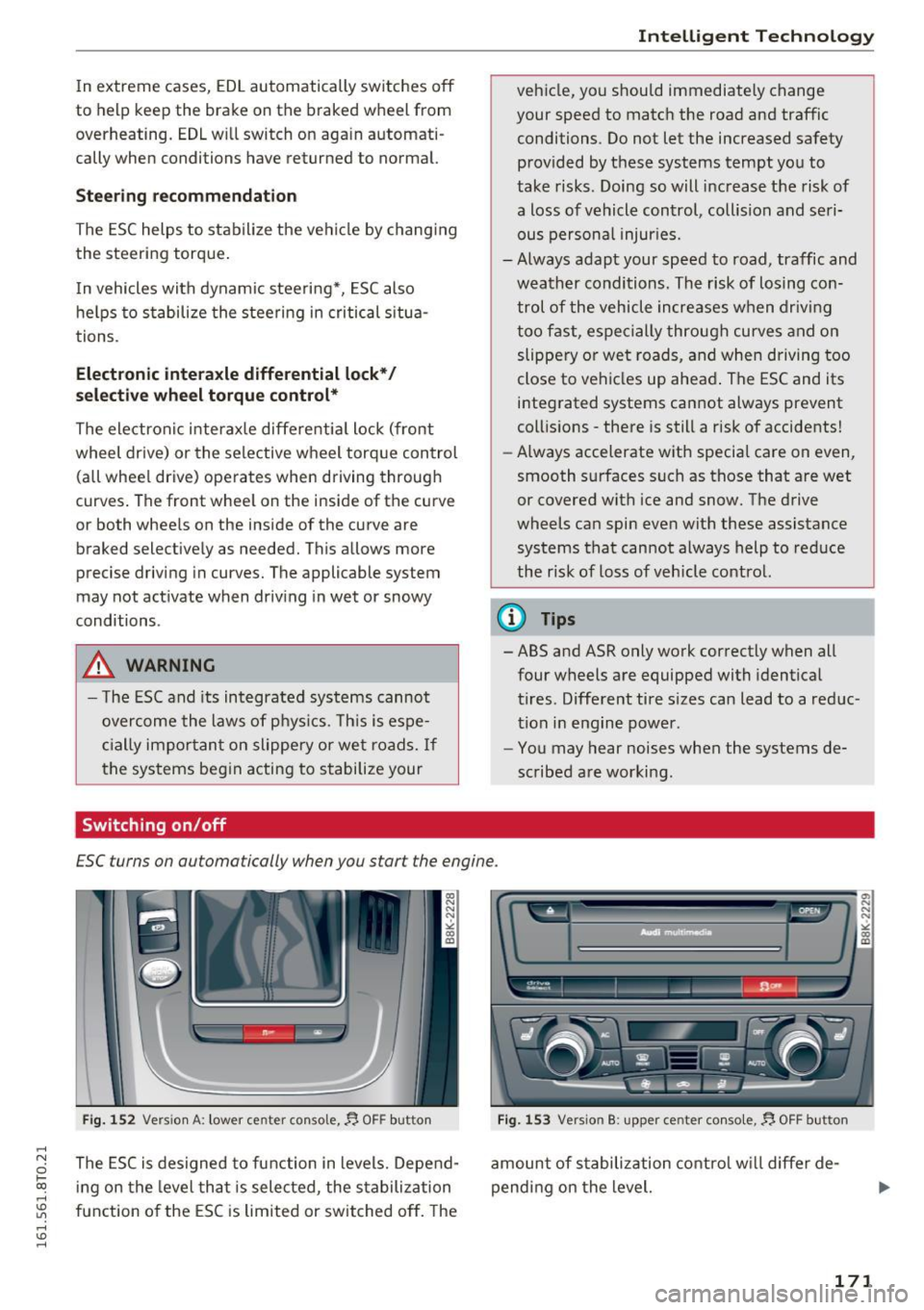
,-1 N
0 1-CX)
,-1 I.Cl U"I
,-1 I.Cl ......
In extreme cases, EDL automatically switches off
to help keep the brake on the braked wheel from
overheating. EDL w ill switch on aga in automati
cally when conditions have returned to normal.
Steering recommendation
The ESC helps to stabilize the vehicle by changing
the steering torque .
In vehicles with dynamic steering*, ESC also
helps to stabilize the steering in critical situa
tions.
Electronic interaxle differential lock*/
selective wheel torque control*
The electronic interaxle differential lock (front
wheel drive) or the selective wheel torque control
(all wheel drive) operates when driving through
curves . The front wheel on the inside of the curve
or both wheels on the inside of the curve are
braked selectively as needed. This allows more
precise driving in curves. The applicable system
may not activate when driving in wet or snowy
conditions .
_&, WARNING
- The ESC and its integrated systems cannot
overcome the laws of phys ics. Th is is espe
cially important on slippery or wet roads.
If
the systems begin acting to stabilize your
Switching on /off
Intelligent Technology
veh icle, you should immediately change
your speed to match the road and traffic conditions. Do not let the increased safety
provided by these systems tempt you to
take risks. Doing so will increase the risk of
a loss of vehicle control, collision and seri
ous personal injuries.
- Always adapt your speed to road, traffic and
weather conditions. The risk of losing con
trol of the vehicle increases when driving
too fast, especially through curves and on
slippery or wet roads, and when driving too
close to vehicles up ahead . The ESC and its
integrated systems cannot always prevent
collisions -there is still a risk of accidents!
- Always accelerate with special care on even,
smooth surfaces such as those that are wet
or covered with ice and snow. The drive
wheels can spin even with these assistance systems that cannot always help to reduce
the risk of loss of vehicle control.
{!) Tips
- ABS and ASR only work correctly when all
four wheels are equipped with identical
tires. Different tire sizes can lead to a reduc
tion in engine power.
- You may hear noises when the systems de
scribed are working .
ESC turns on automatically when you start the engine.
Fig. 152 Version A: lower center console,~ OFF button
The ESC is designed to function in levels. Depend
ing on the level that is selected, the stabilization
function of the ESC is limited or switched off. The
Fig. 153 Version B: upper center console,~ OFF button
amount of stabilization control will differ de
pending on the level.
a, N N N ,.: CX) m
171
Page 174 of 264
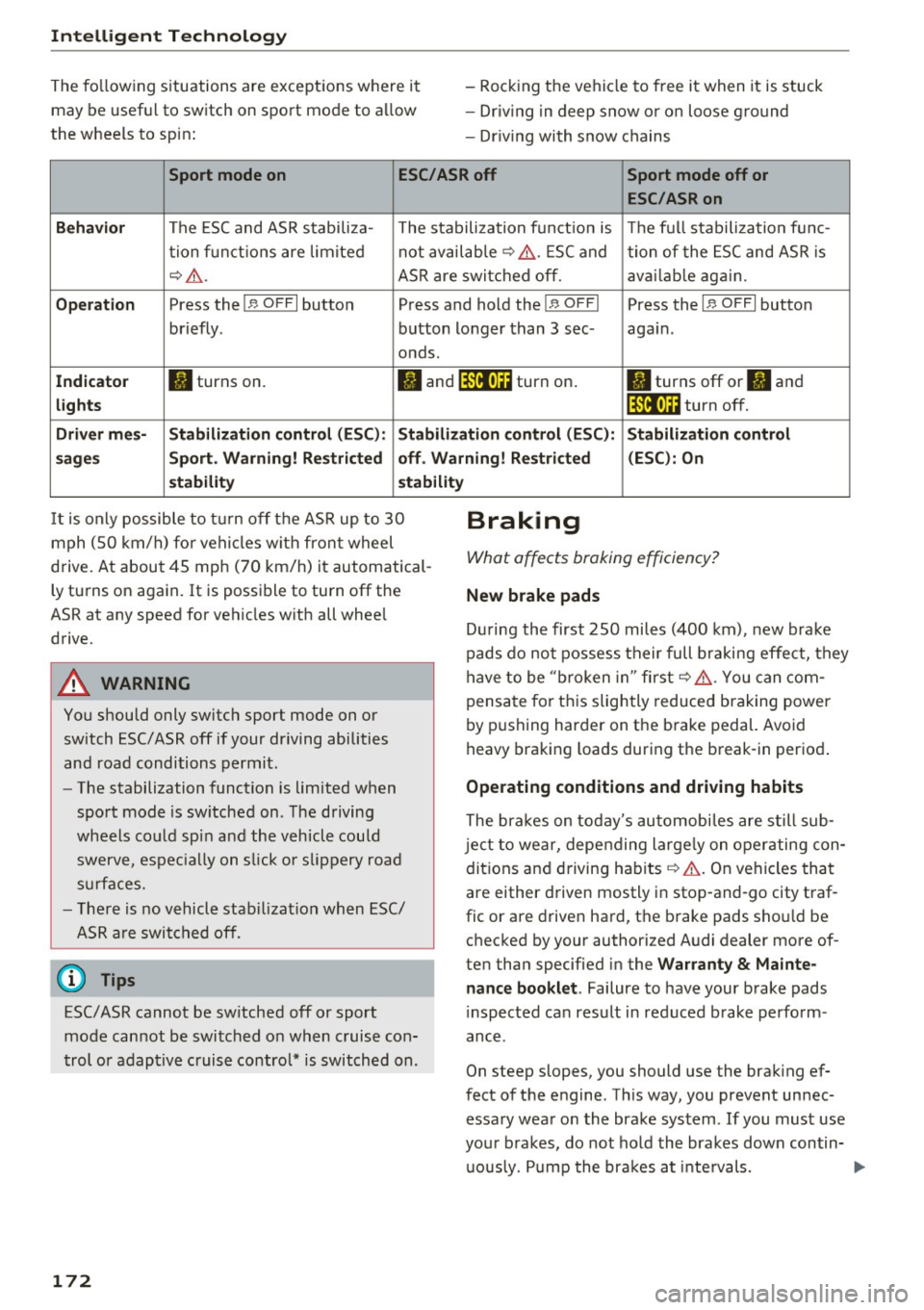
Intelligent Technology
The fo llowing s ituations are exceptions where it
may be useful to switch on sport mod e to a llow
the wheels to sp in : -
Rock ing the vehicle to free it when it is stuck
- Dr iv ing in deep snow or o n loose g ro und
- Dr iving with snow chains
Sport mode on ESC/ASR off Sport mode off or
ESC/ASRon
Beha vior
The ESC and ASR stabiliza- The stabilization funct ion is The f ull stabilization fun c-
t ion f un ct ions are lim ited not availab
le ¢ ,&. . ESC and
tion of the ESC and ASR is
¢ .&. .
ASR are switched off. ava ilab le aga in.
Op era tion Press the I 1> OFF I button Press and hold the !1> O FFI Press the I,, OFF I button
briefly . button longer than 3 sec- again.
onds .
In dicato r II turns on.
• and lf'lii•li~ turn on . II turns off or II and
light s lf'lii•l~~ turn off.
Driv er m es- Stabilization contr ol (E S C): Stabilization control (ESC ): Stabilization control
s age s Sport. Warning! Restri cted off . Warning ! Re stri cted (ESC
): On
s t a bilit y stabilit y
It is only possible to t urn off the ASR up to 30
mph (SO km/h) fo r vehicles w ith front wheel
d rive. At about 45 mph (70 km/h) it automatical
ly tu rns on again. It is possible to turn off the
ASR at any speed for vehicles w ith all whee l
drive .
A WARNING
You should only switch sport mode on or
switch ESC/ASR off if your driving abilities
and road conditions permit .
-
-The stabilization function is limited when
sport mode is sw itched on . The driving
wheels co uld spi n and the vehicle could
swerve , espec ia lly on s lick o r slippery road
s ur faces.
- The re is no vehicle stab ilizat ion when ESC/
ASR a re switched off.
(D Tips
ESC/ASR cannot be sw itched off or sport
mode cannot be switched on when cruise co n
t rol or adaptive cruise control* is switched on .
172
Braking
What affects braking efficiency?
New brake pads
D ur ing the first 250 miles (400 km) , new brake
pads do not possess their full b raking effe ct, they
have to be "b roken in" first ¢,&. . You can com
pensa te for th is slightly reduced b raking power
by p ushing harder on the brake pedal. Avo id
heavy braking loads dur ing the break-in period .
Operating conditions and driving habits
The brakes on today's automobi les are s till sub
je ct to wear, depending large ly on operating con
dit ions and driving habits ¢.&. . On vehi cles that
a re either driven mostly i n stop-and-go city traf
fic or are drive n hard, the b rake pads sho uld be
checked by your authorized A udi dealer more of
ten than specified in the
Wa rrant y & Mainte
nance book let .
Failure to have your brake pads
i nspected can result in reduced brake perform
ance .
On steep slopes, you should use the brak ing ef
fect of the engine . Th is way, you prevent unnec
essary wear on the brake system . If you must use
your brakes, do not ho ld the bra kes down contin
u ously. P ump the bra kes at inte rvals.
Page 175 of 264
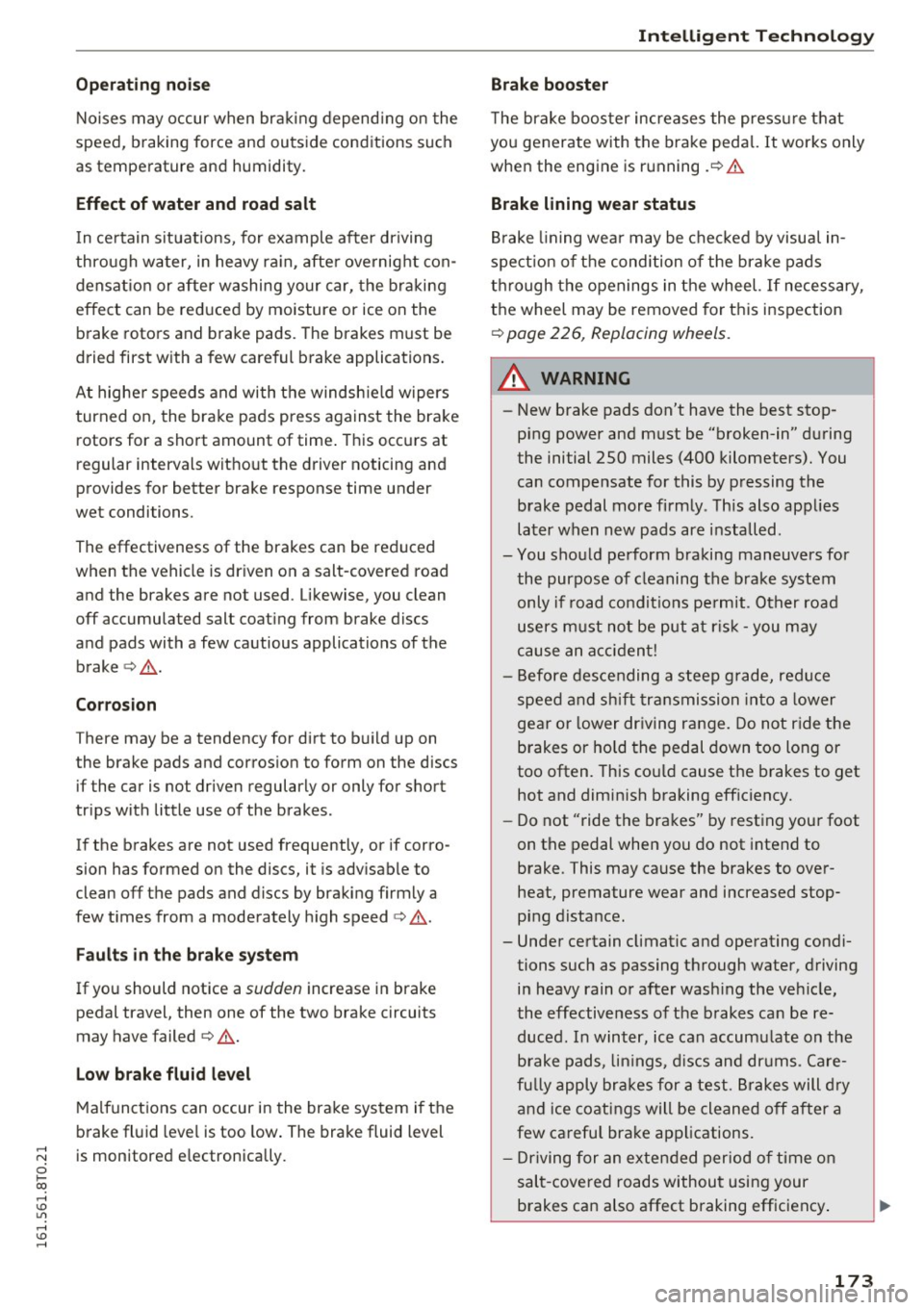
.... N
0 I-co ....
Noises may occur when braking depend ing on the
speed, braking force and outside conditions such
as temperature and humidity.
Eff ect of wat er and road salt
In ce rtain situations, for example after dr iving
through water, in heavy ra in, afte r ove rnig ht con
densat io n or after washing your car, the braking
effect can be reduced by moisture or ice on the
brake rotors and brake pads. The brakes must be
dried first with a few careful brake applications .
At highe r speeds and with the windsh ie ld wipers
turned on, the brake pads press against the brake rotors for a short amount of time . This occurs at
regular intervals without the driver noticing and
provides for better brake response time under
wet conditions.
The effectiveness of the brakes can be reduced
when the vehicle is driven on a salt-covered road and the brakes are not used . Likewise, you clean
off accumu lated salt coating from brake discs
and pads with a few cautious applications of the
brake ~,&. .
Cor ro sion
There may be a tendency for dirt to b uild up on
the brake pads and corros ion to form on the discs
if the car is not driven regularly or only for short
tr ips with little use of the brakes .
If the brakes are not used frequently, or if corro
sion has formed on the discs, it is adv isable to
clean off the pads and discs by braking firmly a
few t imes from a moderately high speed
c:> ,&. .
Fa ults in the brake sy stem
If you should notice a sudden increase in brake
pedal travel, then one of the two brake circuits
may have failed
c:> ,&. .
Low brak e fluid level
M alfunct ions can occur in the brake system if the
b rake fluid leve l is too low . The brake fluid level
is monitored e lectronically .
Intelligent Technology
Brake booster
The brake boos ter increases the press ure that
you generate with the brake peda l.
It works only
when the eng ine is running
. c:> .&.
Brake lining wear status
B rake lining wea r may be chec ked by visua l in
spe ct ion of the condi tion of the brake pads
t hr ough the openings in the wheel. If necessary,
the wheel may be removed for this inspection
c:> page 2 26, Replacing wheels .
_8 WARNING "'---
-New brake pads don't have the best stop
ping power and m ust be "broken-in" during
the initial 250 miles (400 kilometers). You can compensate for this by p ressing the
brake pedal more firmly . This also app lies
later when new pads are installed.
-
- You shou ld pe rform braking maneuvers for
the purpose of cleaning the brake system
only i f road condit ions pe rmit . Other road
users m ust not be put at r is k -you may
cause an ac ciden t!
- Before descending a s teep g rade , reduce
speed and sh ift tr ansmi ssion into a lower
gear or lower dr iving range. Do not r ide the
brakes or hold the pedal down too long or
too often. This co uld cause the brakes to get
hot and dimin ish braking eff ic iency.
- Do not "ride the bra kes" by resting your foot
on the pedal when you do not intend to brake. This may cause the brakes to over
heat, premature wear and increased stop
ping distance.
- Unde r ce rtain climatic and operating condi
tions such as passing through water, driving in heavy rain or after wash ing the veh icle,
the effectiveness o f the brakes ca n be re
duced. In winter, ice can accumu late on the
brake pads, lin ings , d is c s and dr ums . Care
fu lly apply br akes for a test. Brakes will dry
and ice coatings will be cleaned off after a
few careful bra ke applications .
- Driving for an extended period of time on
salt -covered roads without using your
brakes can also affect braking eff iciency .
173
Page 176 of 264
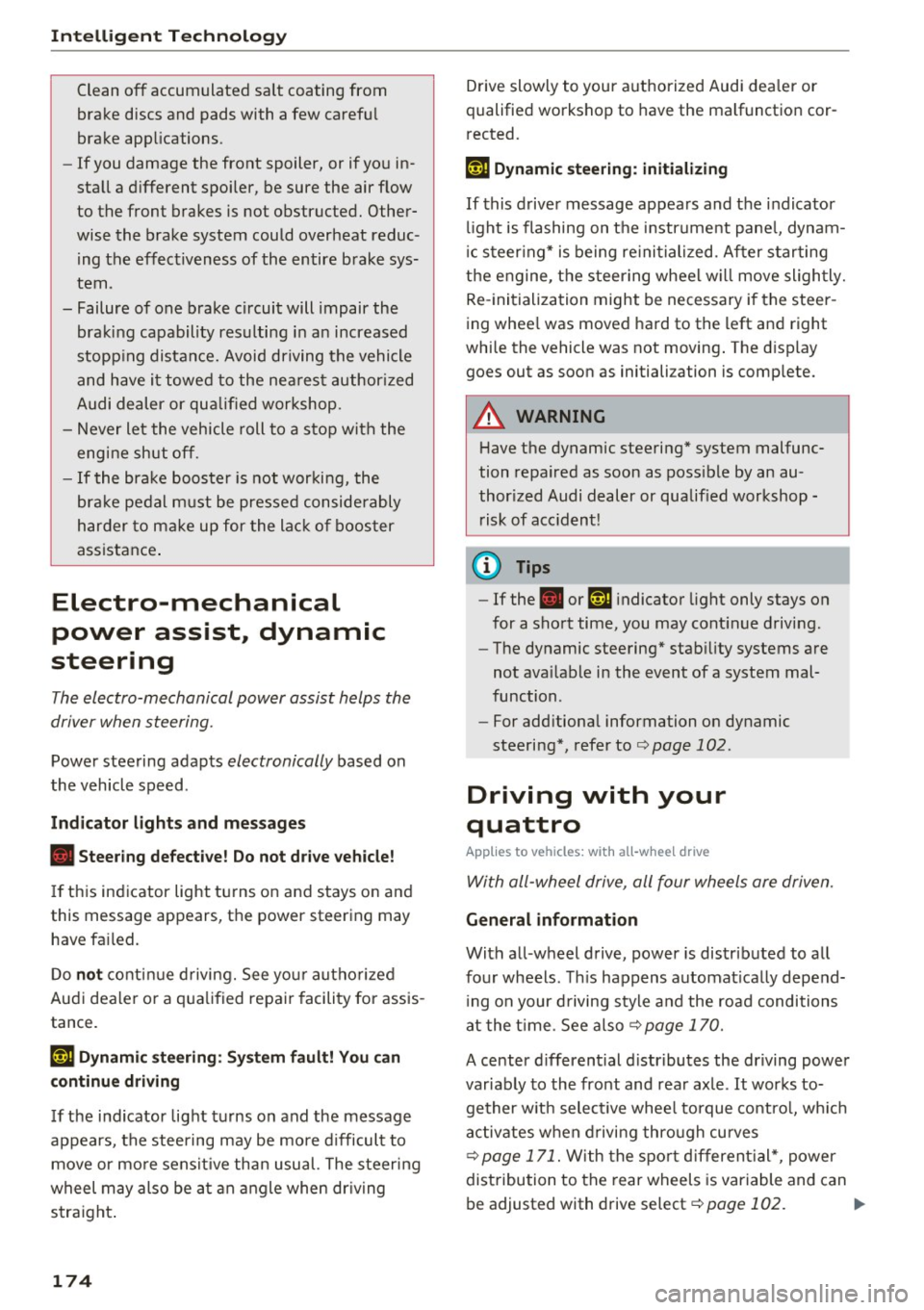
Intelligent Technology
Clean off accumulated salt coating from
brake discs and pads with a few caref ul
brake app lications.
- If you damage the front spoiler, or if yo u in
stall a d ifferent spoiler, be sure the air flow
to the front brakes is not obstructed. Other
wise the brake system could overheat reduc
ing the effectiveness of the entire b rake sys
tem.
- Failure of one brake c ircuit will impair the
bra king capability res ult in g in an increased
stopp ing distance. Avoid driving the vehicle
and h ave i t towe d to the ne arest author ized
Audi dealer or quali fied workshop.
- Never let the vehicle roll to a s to p wi th the
eng ine shut off.
- I f the bra ke booste r is not wor kin g, the
bra ke pe dal m ust be presse d considerably
harder to make up for the lac k of b oos ter
assistance .
Electro-mechanical
power assist, dynamic
steering
The electro-mechanical power assist helps the
driver when steering.
Power steering adapts electronically based on
the vehicle speed .
Indicator lights and mess ages
• Steering defective! Do not dri ve vehicle!
If thi s ind icator light tu rns on and stays o n and
this message appears, t he power steering may
have fa iled.
D o
not conti nue d riving. See yo ur autho riz ed
Aud i dea ler o r a q ua lified repair facility fo r assis
tance.
l;r-ij Dynamic steering : Sy stem fault! You can
c ontinue driving
If t he i ndicator lig ht t urns on and the message
appears, the steering may be more difficult to
move or mo re sens it ive than usual. The steer ing
wheel may also be a t an an gle when dr iv ing
s tra ight .
174
Drive slowly to your a uth orized Audi dea ler or
qualified workshop to have the malfunction cor
r ected.
'I-ij Dynamic steering: initializing
If this d rive r message appea rs and t he in dicator
li ght is flashing on the instr ume nt pa nel, dynam
ic steer ing * is being re ini tiali zed. After s tarting
the e ngine, t he s teer ing whee l w ill move sligh tly.
Re -initializa tion might be necessary if the steer
ing whee l was moved hard to the left and right
whi le the vehicle was not moving . T he d isp lay
goes out as soon as initiali zation is comp lete.
A WARNING
-
H ave the dynamic steering* system malfunc-
tion repaired as soon as poss ible by an au
thor ized Audi dealer or qualified workshop -
risk of acc ident!
@ Tips
- If the . or 'I-ij indicator light only stays on
for a sho rt time, you may cont inue driving.
- The dynamic steerin g* stab ility systems a re
not ava ilable in the event of a system mal
function .
- For add itiona l information on dynamic
steeri ng*, refer to
<=> page 102.
Driving with your
quattro
Applies to vehicles: with all-whee l dr ive
With all-wheel drive, all four wheels are driven.
General informat ion
With a ll-w heel d rive, power is distri buted to a ll
fo ur wheels. This happens automat ica lly depend
i ng on your d riving style a nd the roa d conditions
at the t ime . See also
c> page 170.
A center d ifferen tial d istr ibu tes the dr iving powe r
variab ly to the front and rear ax le.
It works to
gether w it h select ive whee l torque contro l, w hich
ac tiv ates w hen d rivi ng thro ugh curves
<=> page 171. With the spo rt different ial *, power
distribution to the rear wheels is variable and can
be adjusted with drive select<::>
page 102. .,.
Page 177 of 264

.... N
0 Ico ....
engine power. Your vehicle is exceptionally pow
erful and has excellent driving characterist ics
both under normal dr iving condit ions and on
snow and ice. Always read and fo llow safety pre
cautions <=>
,&.
Winter t ire s
When driving in the winter, your vehicle with a ll
wheel drive has an advantage, even with regular
tires. In winter road conditions it may be adv isa
ble to mount w inter tires (or all-season tires) for
i mproved driveab ility and brak ing : these tires
must be mounted on
all four wheels . See also
<=> page 220, Winter tires.
Tire chains
Where tire chains are mandatory on certain
roads, this normally also applies to vehicles w it h
all -wheel drive <=>
page 220, Snow chains.
Replacing wheels /tires
Vehicles with all-whee l dr ive must always have
tires of the same size. A lso avoid tires with differ
ent tread depths. For details see page
<=>
page 212, New tires or wheels.
Off-Road dri ving ?
Your Aud i does not have enough ground clear
ance to be used as an off-road vehicle.
It is there
fore best to avoid rough tracks and uneven ter rain as much as possible . Also refer to
<=> page 177 .
A WARNING
Always adjust your driving to road and t raff ic
conditions. Do not let the extra safety affo rd
ed by all-wheel drive temp t yo u into ta king
extra risks.
- Although the all-whee l drive is very effec
t ive, a lways remember th at br akin g capac ity
is limited by tire traction. Yo u should t here
f ore not drive at excess ive speeds on icy or
slippery road surfaces.
- On wet road surfaces, be caref ul no t to drive
too fast because the front wheels co uld be
gin to slide on top of the water (aq uaplan
ing). If this shou ld occur, you wi ll have no
Intellig ent Technology
warn ing from a s udden increase in engine
speed as w ith a front-wheel drive vehicle.
Always drive at speeds which are suited to the road conditions - risk of crash .
Energy management
Starting ability is optimized
Energy management controls the distribution of
elec trical energy and thus optimizes the availa
bility of ele ctrical energy for star ting the engine.
If a vehicle with a conventiona l energy system is
not dr iven fo r a long pe riod of time, the batte ry is
discharged by id ling curre nt cons umers (e.g. im
mobili ze r). In cer tain circumstances i t can res ult
in the re being insuffi cien t energy ava ilable to
start the engine .
Intellige nt energy manageme nt in yo ur vehicle
hand les the distri bu tion of elec trical energy.
Start ing ability is markedly improved and the life
of the battery is extended .
B as ic all y, energy managemen t cons ists of
bat
tery diagn osis , idling current man agement
a nd
d ynamic energy man agement.
Battery diagnosis
Battery d iagnosis con tinuously dete rmines the
state of the bat tery. Sensors de termine battery
vo ltage, b attery curren t and batte ry tempera
tu re. This de termines t he current state of charge
and the power of the battery .
Idling current management
Idling cur rent management reduces ene rgy con
s u mption wh ile the vehicle is standi ng. With the
ignition swi tched off , it co ntrols the energy sup
ply to the vario us elec trical components . Data
from battery diagnosis is considered .
Depend ing on the ba tte ry's s ta te of charge, indi
v idual consumers are g radually turned off to pre
ven t excess ive d ischarge of the battery and thus
maintain starting capab il ity.
Dynamic energy management
While the vehicle is being driven, dynam ic ene rgy
manageme nt dis trib utes the energy generated ""'
175
Page 178 of 264
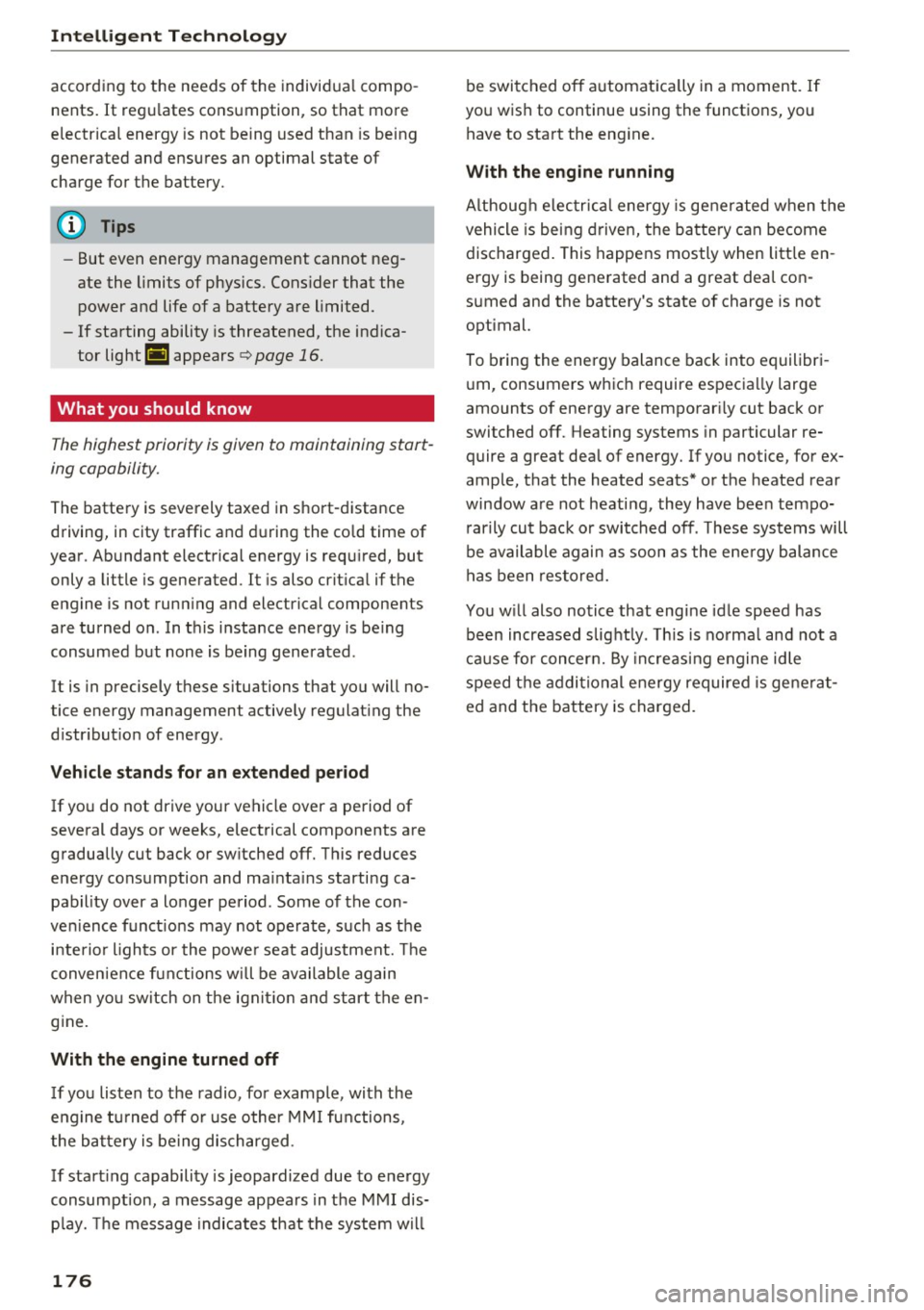
Intelligent Technology
according to t he needs of the individua l compo
nents. It regu lates consumption , so that more
e lectr ical energy is not being used than is being
generated and ensures an optimal state of
charge for the battery.
(D Tips
- But even energy management cannot neg
ate the limits of physics . Cons ider that the
power and life of a battery are limited.
- If starting ability is threatened, the indica
tor light (•) appears ¢
page 16.
What you should know
The highest priority is given to maintaining start
ing capability.
The batte ry is severely taxed in short-distance
driving, in c ity traffic and d uring the co ld time of
year. Abundant electrical energy is req uired, but
only a little is generated . It is also c rit ica l if the
engine is not runn ing and electrical components
are turned on . In this instance energy is be ing
consumed but none is be ing generated .
It is in precisely t hese situations that you will no
tice energy management active ly regulat ing the
d istr ibut ion of energy .
Vehicle stands fo r an e xtended period
If you do not drive your vehicle over a period of
several days or weeks, electrical components are
gradually cut back or sw itched off. T his reduces
energy consumption and ma inta ins starting ca
pab ility over a longer period . Some of the con
ve nience funct ions may not ope rate, such as the
i n terio r lights or the powe r seat adjustment. The
conven ience f unc tions w ill be available again
when yo u switch on the ign it io n and s tart the en
g ine.
With the engine turned off
I f you listen to t he radio, fo r example , with the
engine tu rned off o r use other MMI functions,
the batte ry is being discharged.
If start ing capabili ty is jeopardized due to energy
consumpt ion, a message appears in t he M MI dis
p lay. The message indicates that the system wi ll
176 b
e switched off a utomat ica lly in a moment . If
you wish to continue using the functions, you have to sta rt the eng ine.
With the engine running
Althoug h elec trica l energy is gene rated w hen t he
vehicle is bei ng drive n, the batte ry can become
discharged. This happens mostly when little en
ergy is being generated and a great dea l con
s u med and the battery 's state of charge is not
optimal.
To bring the energy balance back into equilibri
u m, consumers whic h require espec ia lly large
amounts of energy are temporar ily cut back or
switched off. Heating systems in particular re
quire a great dea l of energy. If you notice, for ex
ample, that the heated seats* o r the heated rear
window are not heati ng, they have bee n tempo
r arily cut back o r switched off . These systems will
be available again as soon as the ene rgy balance
has been res tored.
You w ill also no tice that eng ine idle speed has
been increased slig htly . T his is no rma l and not a
ca use for concer n. By in cr easi ng engine idle
speed t he ad ditional energy required is gene rat
ed and the battery is charged.
Page 179 of 264
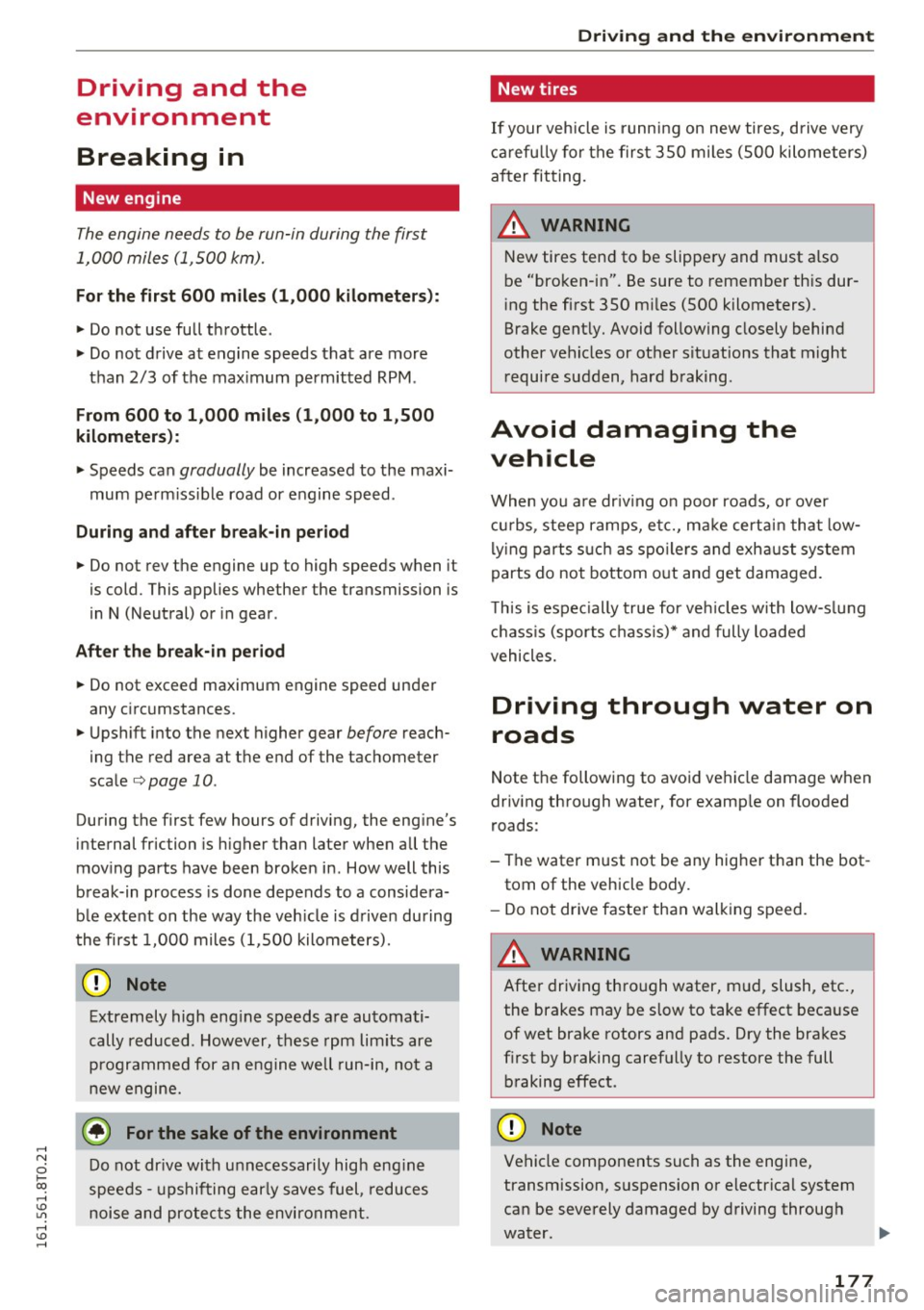
.... N
0 Ico ....
environment
Breaking in
New engine
The engine needs to be run-in during the first
1,000 miles (1,500 km).
For the first 600 miles (1 ,000 kilometer s):
"' Do not use full throttle .
"' Do not drive at engine speeds that are more
than
2/3 of the max imum permitted RPM .
From 600 to 1,000 miles (1 ,000 to 1 ,500
kilometers):
"' Speeds can gradually be increased to the maxi
mum pe rm issib le road or engine speed .
During and after break-in pe riod
"' Do not rev the engine up to high speeds when it
is cold. This applies whether the transmission is
in N (Neutral) or in gear .
After the break-in period
"'Do not exceed maximum engine speed under
any c ircumstances.
"'U pshift into the next higher gear
before reach
ing the red area at the end of the tachometer
sca le
c=>page 10.
During the first few hours of driving, the eng ine's
internal friction is higher than later when all the
mov ing parts have been broken in . How well this
b reak-in process is done depends to a considera
b le exte nt on the way the veh icle is d rive n during
t he first 1,000 miles (1,500 kilometers).
(D Note
Extremely high eng ine speeds a re au toma ti
cally reduced. However, these rpm limits are
programme d for a n engine well run-in, not a
new engine.
@) For the sake of the environment
D o not dr ive with u nnecessari ly high eng in e
spee ds -ups hifting ea rly saves fuel, reduces
noise and pro tec ts the envi ronme nt.
Driving and the envir onment
New tires
If your vehicle is runn ing on new tires, d rive very
car efu lly fo r the firs t 35 0 miles (500 kilometers)
a ft er fit ting.
New tires tend to be slippe ry and must a lso
be "bro ken-in". Be sure to remembe r th is dur
i ng the fi rst 350 m iles (500 kilometers).
Brake gent ly. Avoid following closely behind
other vehicles or other s ituations that m ight
r equire sudden, hard b raking.
Avoid damaging the
vehicle
When yo u are dr iv ing o n poor roa ds, or over
cur bs, stee p ramps, e tc., ma ke cert ain that low
ly ing parts s uch a s spo ile rs a nd exh aust sy stem
parts do no t bottom o ut and get dama ged.
T his is espec ially true for ve hicles with low-s lung
c h ass is (sports c hass is) * and fully loaded
vehicles.
Driving through water on
roads
Note t he following to avoi d ve hicle damage w hen
driv ing through water, for examp le on flooded
roads:
- The water must not be any hig her t han the bot
tom of the vehicle body.
- Do not dr ive faste r than walk ing speed.
A WARNING
= -
Afte r driv ing th ro ugh water, m ud, slush, etc .,
the brakes may be slow to take effect beca use
of wet brake rotors and pa ds. Dry the brakes
f irst by braking carefully to restore the full
b raking effect.
(D Note
Ve hicle compone nts such as the engine,
transmission, suspension o r electrica l system
can be severely damaged by driving throug h
water.
177
Page 180 of 264
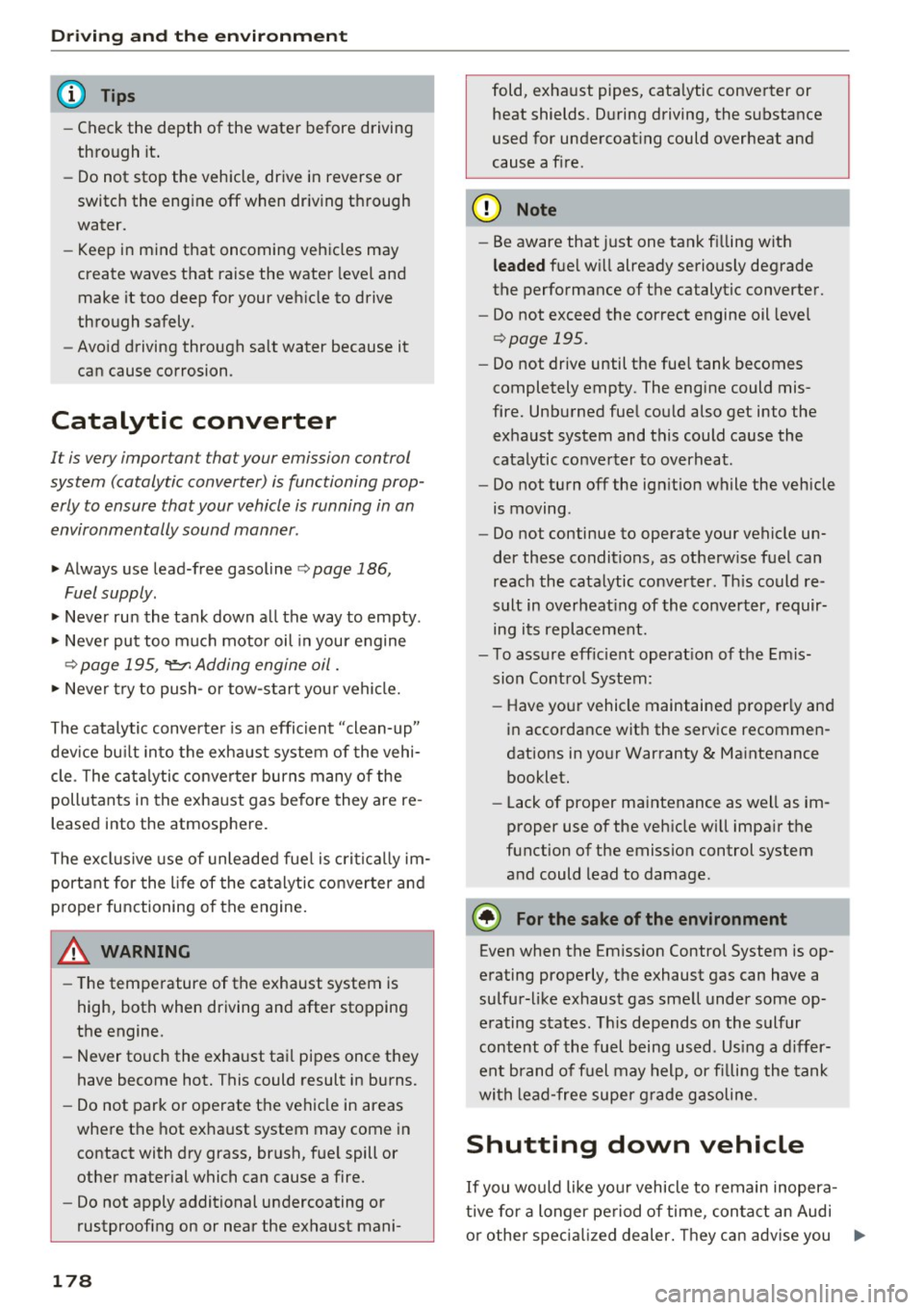
Driving and th e en vironm ent
(D Tips
- Check the depth of the water before driving
through it .
- Do not stop the veh icle, drive in reverse or
switch the engine
off when driving through
water.
- Keep in mind that oncoming vehicles may
create waves that raise the water level and
make it too deep for your veh icle to drive
through safely.
- Avoid driving through salt water because it
can cause corrosion.
Catalytic converter
It is very important that your emission control
system (catalytic converter) is functioning prop erly to ensure that your vehicle is running in an
environmentally sound manner .
~ Always use lead-free gasoline ¢ page 186,
Fuel supply .
~ Never run the tank down a ll the way to empty .
~ Never put too much motor oil in your engine
¢ page 195, 9::?1 Adding engine oil .
~ Never try to push- or tow-start you r vehicle.
The cata lytic converter is an efficient "clean-up"
dev ice bu ilt into the exha ust system of the vehi
cle. The cata lytic conve rter burns many of the
pollutants in the exhaust gas before they are re
leased into the atmosphere.
The exclusive use of unleaded fue l is critica lly im
portant for the life of the catalytic conve rter and
p roper functioning of the engine.
A WARNING ,..____ -
- The temperature of the exhaust system is
high, both when driving and after stopping
the engine.
- Never touch the exha ust tail pipes once they
have become hot. This could result in burns.
- Do not park or ope rate t he vehicle in areas
where the hot exha ust system may come in
contact with dry grass, br ush, fue l spill or
other mater ial which can cause a fire.
- Do not apply additional undercoating or
rustproofing on or near the exhaust mani-
178
fold, exha ust pipes, cata lytic conve rter or
heat shields. D uring driving, the substance
used for undercoat ing could overheat and
cause a f ire.
Cl) Note
- Be aware that just one tank f illing wit h
leaded fu e l w ill already seriously degrade
the performance of the catalytic converter.
- Do not exceed the correct engine oil leve l
¢page 195.
-Do not drive until the fue l tank becomes
completely empty. The engine could mis
fire. Unbu rned fue l cou ld also get into the
exhaust system and this could cause the
catalytic converter to overheat.
- Do not turn off the ign ition while the vehicle
is moving .
- Do not continue to operate your vehicle un
der these conditions, as otherw ise fuel can
reac h the catalytic converter. T his could re
sult in overheat ing of the converter, requir
ing its replacement.
- T o ass ure eff icient operat ion of the Emis
sion Contro l System:
- Have you r vehicle maintained properly and
i n accordance wit h the service recommen
dations in your Warranty
& Ma intenance
booklet.
- Lack of proper ma intenance as well as im
p roper use of the veh icle will impa ir the
function of the emission control system
and could lead to damage.
(® For the sake of the environment
Even when the Emiss ion Control System is op
erating properly, t he exhaust gas can have a
sulfur-like exhaust gas smell under some op
erating states. Th is depends on the sulfur
content of the fuel being used. Us ing a d iffer
ent brand of fuel may help, or fi lli ng the tank
wi th lead-free super g rade gasoline.
Shutting down vehicle
If you wo uld like yo ur vehicle to remain inopera
tive for a longer pe riod of time, con tact an Audi
o r other spec ia liz ed dealer. They can adv ise you ..,.